Google Ads click-to-text (SMS) ad extension is available to all Google advertisers and is a great way to give your prospects and customers a convenient way to get in touch. It’s perfect for people who just want information via text, and don’t want to ring you up or send an email.
The increasing use of mobile devices is well documented and inevitably led to Google proceeding with mobile first indexing, among many other mobile-first initiatives. It is therefore no surprise that Google produced a dedicated, mobile user-friendly ad extension to help customer to get in touch with businesses. According to a Google survey:
“60% of Millennials prefer two-way text engagement with companies because it’s convenient, fast, and easy to use”
“65% of consumers say they’d consider using messaging to connect with a business to get information about a product or service, or to schedule an in-person appointment”
What does a Click to Text ad look like?
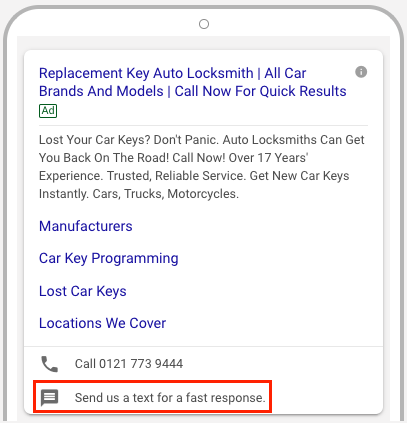
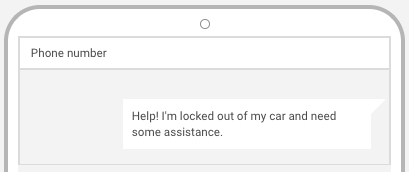
And click to text is being used in a range of industries, from locksmiths to online casinos:
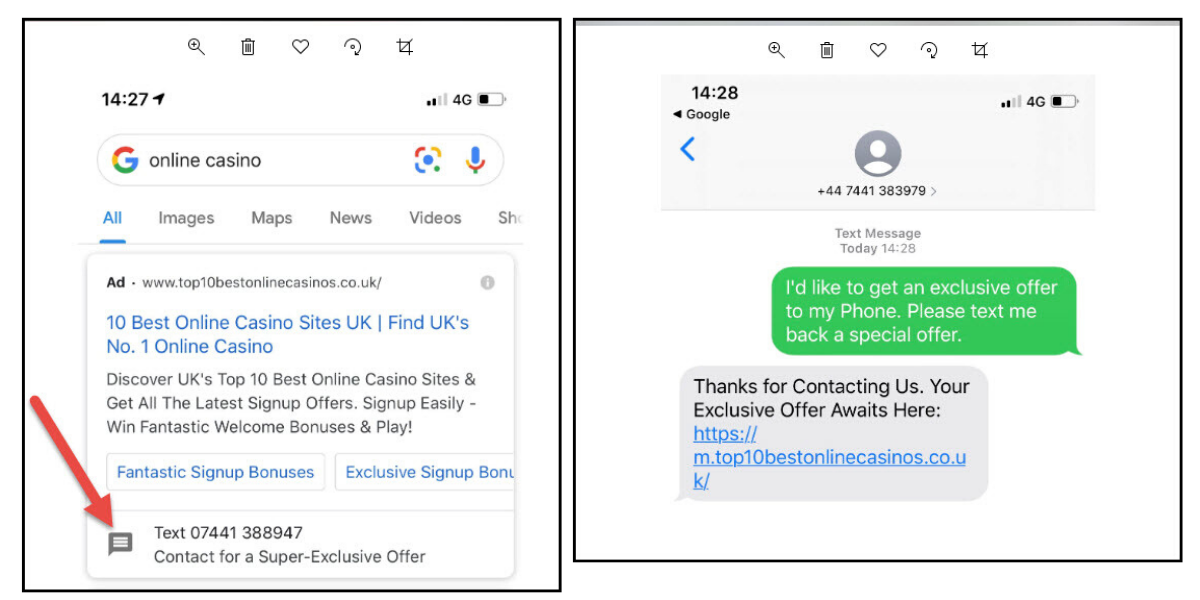
The message extension is a simple three step process:
- The customer clicks the text extension on an ad.
- The customer’s mobile pre-fills a text message to the business’ mobile number initiating a conversation.
- The business can then follow up and close the enquiry.
Do Click to Text ads work?
The answer, in a nutshell, is yes they do.
Looking at the data in the table below, the message click type has one of the highest click thru rates (CTRs) of the different ad formats that Google Ads offers.
The purpose of an ad extension is to improve the ad’s relevance, along with providing users increased convenience, which is certainly the case for the message (click to text) extension. It provides potential customers with an alternative and a more convenient way to open lines of communication with your business. We typically use this extension for businesses which observe high levels of mobile click traffic and of course, if it makes logical sense. The table below is an export from a typical client account which leverages this extension:
| Click Type | Impressions | Clicks | CTR | Avg. CPC | Cost |
| Headline | 104,852 | 6,302 | 6.0% | £2.30 | £14,501 |
| Callout | 84,648 | 5,967 | 7.0% | £1.85 | £11,039 |
| Sitelink | 80,928 | 5,538 | 6.8% | £2.00 | £11,085 |
| Structured snippet | 1,557 | 512 | 32.9% | £0.49 | £253 |
| Location | 3,782 | 364 | 9.6% | £1.27 | £464 |
| Message | 2,014 | 346 | 17.2% | £2.20 | £759 |
| Call | 8,849 | 280 | 3.2% | £4.47 | £1,252 |
To clarify, the ‘Headline’ click type is the element of a search ad which is always present and therefore we see it claim the highest amount of clicks and impressions. All click types beneath this, are reporting data for when that element (ad extension) was present on the advert. So, the ‘Sitelink’ extension was present a vast majority of the time (80,928/104,852 impressions) and when it was, the overall ad achieved a slight boost in Click-Through-Rate (CTR) and a reduction in Cost-Per-Click (CPC).
Based on this data, the click-to-text message extension certainly has a few benefits:
- Though it isn’t served a tremendous amount, when the message extension is present, the ad achieves an impressive 17.2% CTR.
- The average CPC for when the click to text message extension is served is slightly less than the overall average.
This finding is in line with Wordstream’s large-scale analysis, which concluded that:
CTR improvements from message extensions averaged 50% higher than the mobile ad alone! These message extensions even rivalled the success of call extensions.
What does this mean?
In short, the results are promising and feedback from our clients is great, as it gives their customers more options to engage with them. You’re also able to customise and edit many aspects of the extension such as; the Call-To-Action message which is display on the ad, the pre-populated user enquiry message, and you can also choose to create an auto-response, for example: “Thanks for messaging us, we will reply as quickly as possible.”
What is the main application of Click to Text?
The main applications of click to text extensions are likely to be service requests for more information, a callback or quotes. Successful examples for the application of this extension, are for businesses like hotels, car rental services and insurance companies.
Note that, not all businesses will find this feature useful and it will certainly depend on the device usage of your target demographic. You’ll also need to dedicate resource and have the ability to receive the SMS messages and respond within a reasonable timeframe.
How to implement the Click to Text ad extension.
The first thing you’ll need is a number, to be the recipient of any messages. Google encourages larger businesses to explore SMS chat facilities so that they can support SMS enquiries. For smaller businesses, Google suggests using a business mobile phone to reply directly.
With a number in hand, you’ll need to navigate to “Extensions”, within “Ads & extensions” for the ad group or campaign you wish to create the extension for.
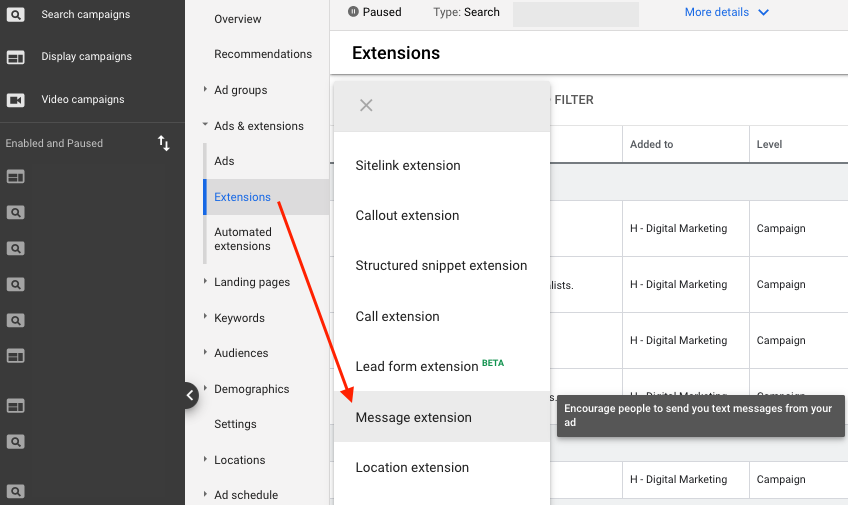
You’ll then be faced with a number of elements to configure.
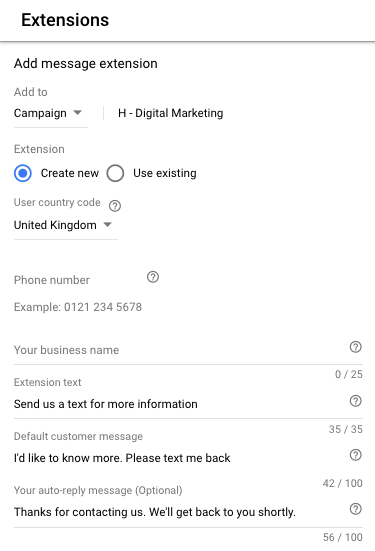
- Add to: choose where you’d like to add the message extension
- User country code: select the country code that matches where your ads show
- Phone number: insert the phone number
- Your business name: insert your business name
- Extension text: this is what the user will see on the ad extension
- Default customer message: this is the pre-filled message that appears in the user’s phone
- Your auto-reply message: you have the option to create an automatic reply
What Are the Drawbacks of Click to Text?
No conversion tracking. Unlike the “click to call” extension, Google cannot report on the number of messages sent. Businesses will need to come up with a method to track the performance of the message extension themselves. A common suggestion is to create a dedicated number which will exist solely, to receive the SMS enquiries. Furthermore, text messaging lends itself well to simple questions or requests but may not be suitable for more complex enquiries – and the channel could be misused by customers, e.g. customer support queries.
All in all, this ad extension is certainly one to explore. It provides a more efficient and convenient method for users to contact your business (especially among younger demographics, who are more inclined to communicate via messaging). With the constraints outlined above, keep an eye on the quality of the inbound messages and assess whether or not it adds real value to your PPC marketing strategy.
Want to know about more useful tools and extensions? We’ll keep you updated:
The post What is Ads Click to Text (SMS) and does it work? appeared first on Hallam.
from Blog – Hallam https://ift.tt/2DJfFhi
via IFTTT
Comments
Post a Comment